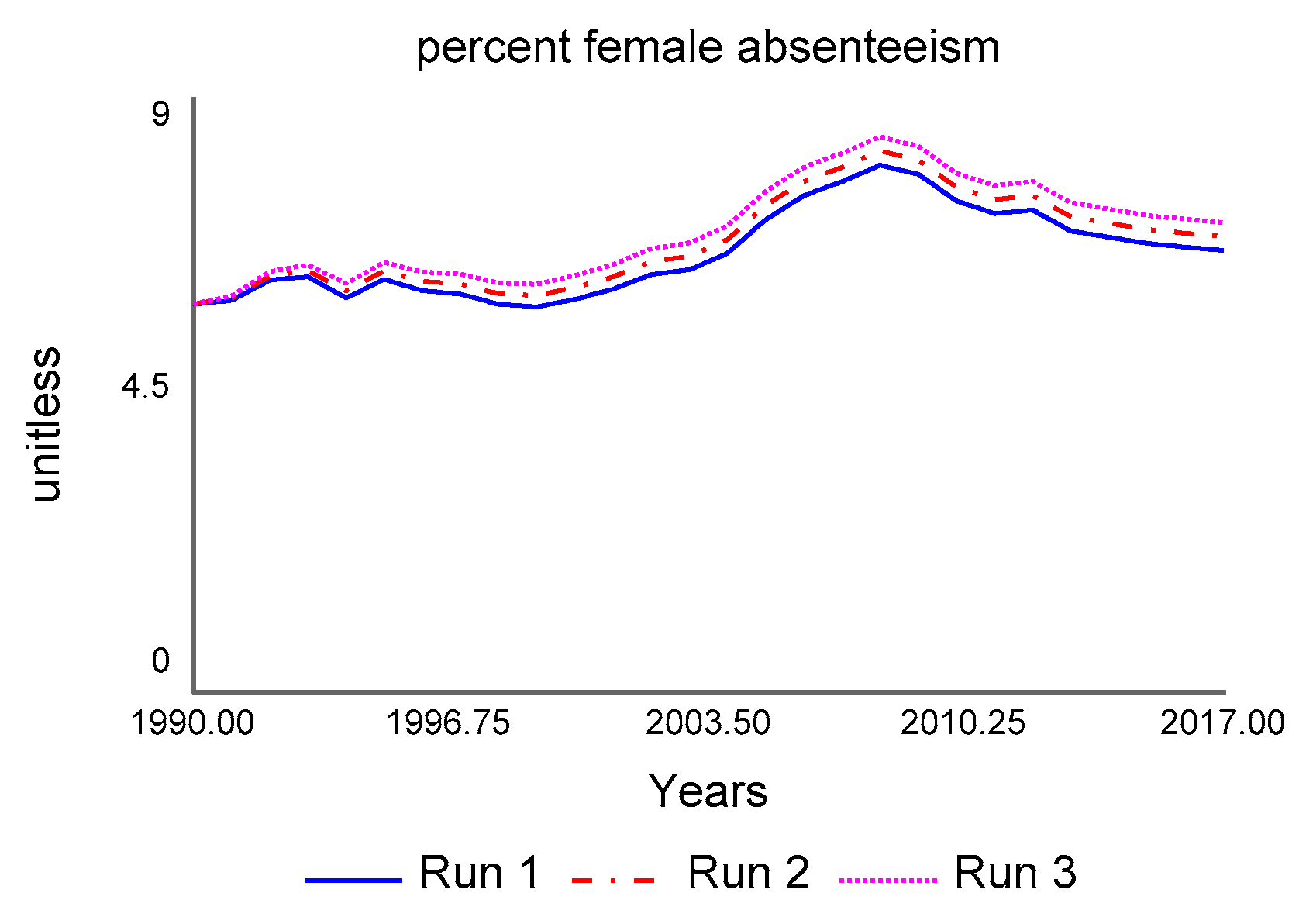The Heavy Cost of Care: Systemic Challenges in Norwegian Work Absenteeism
Abstract
1. Introduction and Background
2. Methods: System Dynamics
2.1. Basic Elements
2.2. Exogenous vs. Endogenous
2.3. Feedback
2.4. Using System Dynamics to Understand Work Absenteeism
3. Results
3.1. Stock and Flow Diagram of Care Work Absenteeism
3.2. Cost to the State
4. Discussion
4.1. Causal Loop Diagram
- (1)
- Part-time work reinforcing loop: As part-time work increases, the level of decision-making involvement decreases. Part-time employees are more likely to have low involvement in decision-making. The more part-time employees there are, the larger the number of employees with a low involvement in decision-making. The larger the number of employees with a low involvement in decision-making, the higher the number of absentees. As discussed earlier, this is due to a loss of control over their daily working life. As absenteeism increases, so does understaffing. This leads to more turnover (higher attrition rate) because of the stress an environment that an understaffed workplace creates. Higher turnover leads to more part-time workers in care work (creating the part-time work reinforcing loop) because more workers are needed to quickly fill staffing needs. This is higher for part-time workers rather than full-time workers in care work because of the path dependency that this system has. Part-time workers are the standard in many care work jobs. It is also important to mention that childbearing/rearing also keeps part-time work high (built into another part of the model, not shown in the SFD in Figure 2).
- (2)
- Fatigue reinforcing loop: Understaffing leads to higher fatigue and higher rates of absenteeism, creating another reinforcing loop (the fatigue reinforcing loop), representing the burnout loop structure in the model.
- (3)
- Hiring balancing loop: The first two reinforcing loops are kept from continually increasing the absenteeism rate by the hiring balancing loop. As absenteeism increases, the more people are hired to replace them, which reduces understaffing. There is a hiring delay however, which keeps hiring from eliminating understaffing.
4.2. Sick or Unemployed?
4.3. The Double Burden
4.4. The Gender Difference in Employment and Diagnoses
4.5. Policy
5. Conclusions
Conflicts of Interest
Appendix A
Appendix A.1. Notes on Model Building
Appendix A.2. Notes on Data and Support for Variables and Relationships
Appendix A.3. Model Equations
Appendix A.4. Notes on Validation
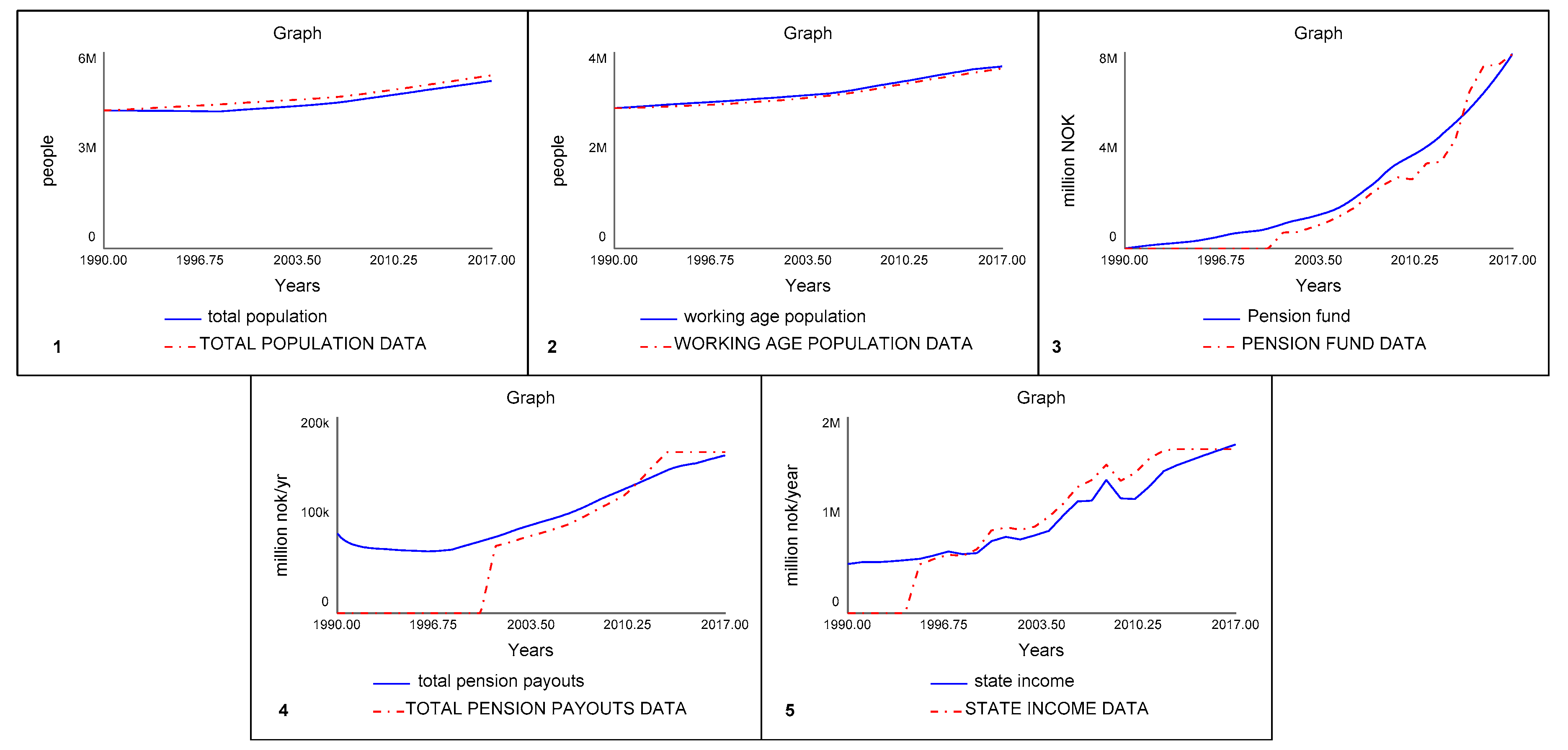
Appendix A.5. Sensitivity Analysis
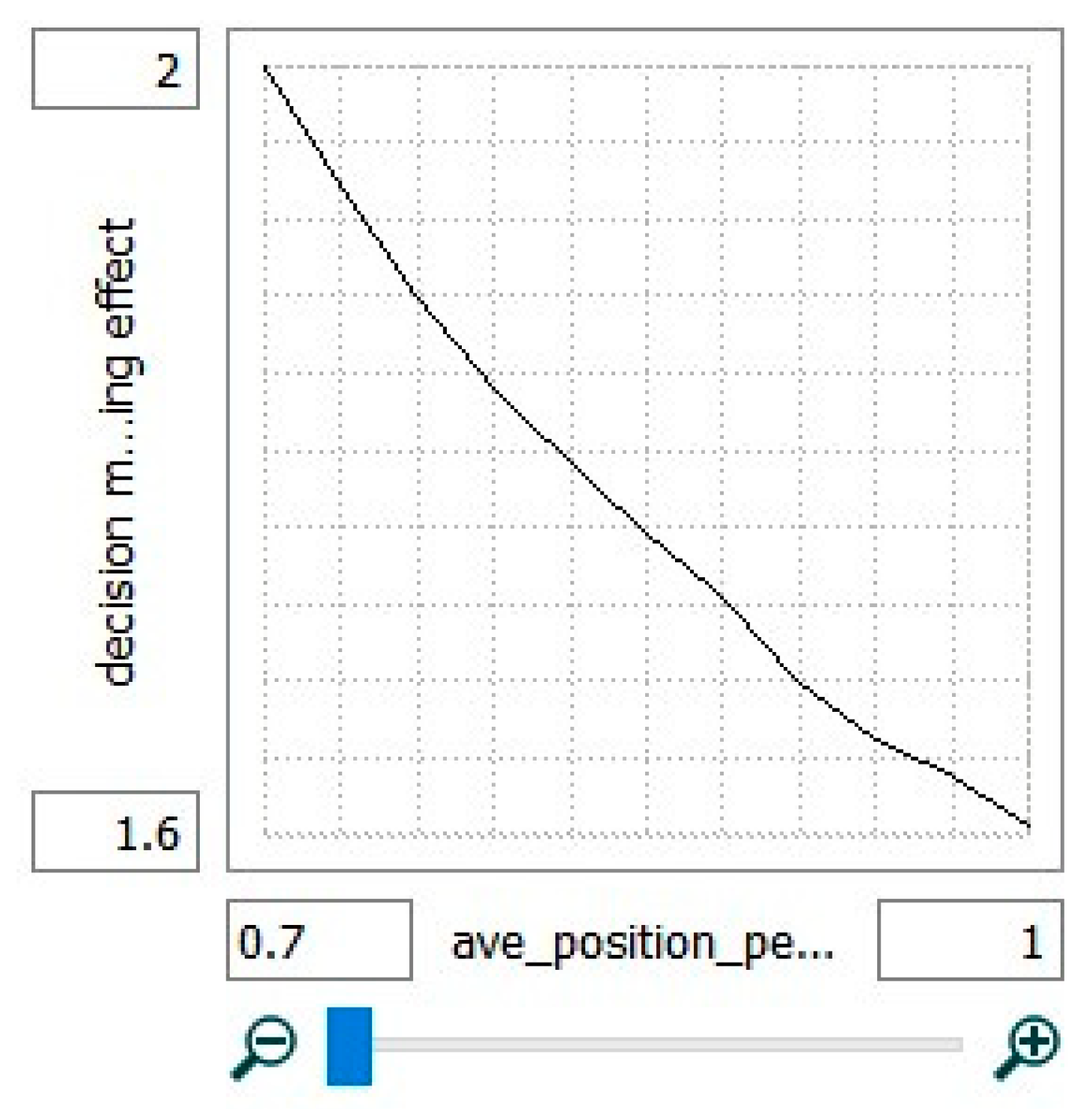
Appendix A.6. Methodological Limitations
References
- Andersen, Torben, Bengt Holmström, Seppo Honkapohja, Sixten Korkman, Hans Söderström, and Juhana Vartiainen. 2007. The Nordic Model: Embracing Globalization and Sharing Risks. Helsinki: Taloustieto Oy. [Google Scholar]
- Bakken, Frøydis. 2009. Det kjønnsdelte arbeidsmarkedet i Norge. Arbeid og Velferd 4: 79–86. [Google Scholar]
- Barford, Sean, and William Whelton. 2010. Understanding Burnout in Child and Youth Care Workers. Child & Youth Care Forum 39: 271–87. [Google Scholar] [CrossRef]
- Barnett, Rosalind. 2004. Women and multiple roles: Myths and reality. Harvard Review of Psychiatry 12: 158–64. [Google Scholar] [CrossRef] [PubMed]
- Bjørnskau, Torkel. 1997. Seks Timers Dag i Omsorgsyrker: En Evaluering av Forsøket i Oslo Kommune, Rapport 232, Forskningsrapport Fafo. Oslo: Falck Hurtigtrykk. [Google Scholar]
- BLS (Bureau of Labor Statistics). 2014. Labor Force Statistics from the Current Population Survey. Available online: http://www.bls.gov/cps/cpsaat47.htm (accessed on 24 April 2016).
- Campos-Serna, Javier, Elena Ronda-Perez, Lucia Artazcoz, Bente Moen, and Fernando Benavides. 2013. Gender inequalities in occupational health related to the unequal distribution of working and employment conditions: A systematic review. International Journal for Equity in Health 12: 12–57. [Google Scholar] [CrossRef] [PubMed]
- Eaton, William, Amanda Kalaydjian, Daniel Scharfstein, Briana Mezuk, and Yu Ding. 2007. Prevalence and incidence of depressive disorder: The Baltimore ECA follow-up, 1981–2004. Acta Psychiatrica Scandinavica 116: 182–88. [Google Scholar] [CrossRef]
- Egeland, Catherine, and Ida Drange. 2014. Frivillig deltid-kun et spørsmål om tid? AFI 4: 2014. [Google Scholar]
- Elstad, Jon Ivar, and Mia Vabo. 2008. Job stress, sickness absence and sickness presenteeism in Nordic elderly care. Scandinavian Journal of Public Health 36: 467–74. [Google Scholar] [CrossRef] [PubMed]
- Esping-Andersen, Gøsta. 1990. Three Worlds of Welfare Capitalism. Cambridge: Polity Press. [Google Scholar]
- Esping-Andersen, Gøsta. 2009. Report to VAM. Norway’s Research Council, Velferd, Arbeidsliv og Migrasjon (VAM). Sentrale Documenter. Norway: Forskningsrådet. [Google Scholar]
- Ferragina, Emanuele, and Martin Seeleib-Kaiser. 2011. Thematic Review: Welfare regime debate: Past, present, futures? Policy & Politics 39: 583–611. [Google Scholar] [CrossRef]
- Gjesdal, Sturla, Espen Bratberg, and John Mæland. 2011. Gender differences in disability after sickness absence with musculoskeletal disorders: Five-year prospective study of 37,942 women and 26,307 men. BMC Musculoskeletal Disorders 12: 37. [Google Scholar] [CrossRef] [PubMed]
- Häggebrink, Ellinor, and Karolin Lovén. 2010. Absence from Work—Sweden, Eurofound. Available online: https://www.eurofound.europa.eu/observatories/eurwork/comparative-information/national-contributions/sweden/absence-from-work-sweden (accessed on 28 April 2016).
- Hansson, Anne-Sophie, Eva Vingard, Bengt Arnetz, and Ingrid Anderzan. 2008. Organizational change, health, and sick leave among health care employees: A longitudinal study measuring stress markers, individual, and work site factors. Work & Stress 22: 69–80. [Google Scholar] [CrossRef]
- Haskins, Cecilia. 2008. Systems Engineering Analyzed, Synthesized, and Applied to Sustainable Industrial Park Development. Ph.D. dissertation, Norwegian University of Science and Technology, Trondheim, Norway. [Google Scholar]
- Hennum, Nicole. 2014. Developing Child-Centered Social Policies: When Professionalism Takes Over. Social Sciences 3: 441–59. [Google Scholar] [CrossRef]
- Homer, Jack, and Gary Hirsch. 2006. System dynamics modeling for public health: Background and opportunities. American Journal of Public Health 96: 452–58. [Google Scholar] [CrossRef] [PubMed]
- Hytti, Helka. 2006. Why are Swedes Sick but Finns Unemployed? International Journal of Social Welfare 15: 131–41. [Google Scholar] [CrossRef]
- Ihlebæk, Camilla, Søren Brage, Bård Natvig, and Dag Bruusgaard. 2010. Forekomst av muskelog skjelettlidelser i Norge. Tidsskrift for den Norske Legeforening 130: 2365. [Google Scholar] [CrossRef]
- Karlsen, Hilde. 2012. Not so Unconventional after All: A Quantitative Study of Men in Care-Oriented Study Programmes and Professional Occupations in Norway. Oslo: Oslo and Akershus University College of Applied Sciences. [Google Scholar]
- Kostøl, Andreas. 2010. Kunnskapsoppsummering av Samfunnsvitenskapelig Litteratur om Årsaker til Sykefravær og Utstøting: Kunnskapsoppsummering til Almlid-Utvalget. Oslo: Statistisk sentralbyrå. [Google Scholar]
- Lane, David. 1999. Social theory and system dynamics practice. European Journal of Operational Research 113: 501–27. [Google Scholar] [CrossRef]
- Magnusson Hanson, Linda, Töres Theorell, Gabriel Oxenstierna, Martin Hyde, and Hugo Westerlund. 2008. Demand, control, and social climate as predictors of emotional exhaustion symptoms in working Swedish men and women. Scandinavian Journal of Public Health 36: 737–43. [Google Scholar] [CrossRef] [PubMed]
- Meadows, Donella. 2008. Thinking in Systems: A Primer. White River: Chelsea Green. [Google Scholar]
- Mitchie, Susan, and Sian Williams. 2003. Reducing work related ill-health and sickness absence: A systematic literature review. Occupational and Environmental Medicine 60: 3–9. [Google Scholar] [CrossRef]
- Montgomery, Tom, Micaela Mazzei, Simone Baglioni, and Stephen Sinclair. 2017. Who cares? The social care sector and the future of youth employment. Policy & Politics 45: 413–29. [Google Scholar] [CrossRef]
- NAV (Arbeids- og velferdsforvaltningen/Norwegian Labour and Welfare Administration). 2014. Sykefraværsstatistikk: Sykefraværstilfeller 4. Kvartal 2005–2014. Diagnose og Kjønn. Antall og Present. Available online: https://www.nav.no/no/NAV+og+samfunn/Statistikk/Sykefravar+-+statistikk/Sykefravar (accessed on 24 April 2016).
- Nikolaou, Ioannis. 2016. Occupational health and safety within corporate social responsibility context: A balanced scorecard dynamic decision making model. International Journal of Decision Support Systems 2: 54–70. [Google Scholar] [CrossRef]
- OECD (Organisation for Economic Co-operation and Development). 2010. Sickness, Disability and Work: Breaking the Barriers: A Synthesis of Findings across OECD Countries. Paris: OECD Publishing. [Google Scholar]
- ONS (Office for National Statistics). 2014. Full Report: Sickness Absence in the Labour Market. Available online: www.ons.gov.uk/ons/dcp171776_353899.pdf (accessed on 24 April 2016).
- Ose, Solveig Osborg, Lin Jiang, and Brita Bungum. 2014. Det Kjønnsdelte Arbeidsmarkedet og Kvinners Arbeidshelse. Trondheim: SINTEF Teknologi og Samfunn. [Google Scholar]
- Palmer, Erika. 2017a. Systems Engineering Applied to Evaluate Social Systems: Analyzing Systemic Challenges to the Norwegian Welfare State. Ph.D. dissertation, University of Bergen, Bergen, Norway. [Google Scholar]
- Palmer, Erika. 2017b. Structural disadvantage: Evidence of gender disparities in the Norwegian pension system. Social Sciences 6: 22. [Google Scholar] [CrossRef]
- SSB (Statistisk sentralbyrå/Statistics Norway). 2010. Women and Men in Norway: What the Figures Say. Available online: https://www.regjeringen.no/globalassets/upload/bld/rapporter/2010/cedaw_rapporten/annex_3.pdf (accessed on 24 April 2016).
- SSB (Statistisk sentralbyrå/Statistics Norway). 2016a. Arbeidskraftundersøkelsen, 1. Kvartal 2016. Available online: https://www.ssb.no/arbeid-og-lonn/statistikker/aku (accessed on 3 May 2017).
- SSB (Statistisk sentralbyrå/Statistics Norway). 2016b. Sykefravær, 4. Kvartal 2015. Available online: https://www.ssb.no/arbeid-og-lonn/statistikker/sykefratot/kvartal (accessed on 3 May 2017).
- SSB (Statistisk sentralbyrå/Statistics Norway). 2017. Sykefravær. Available online: https://www.ssb.no/arbeid-og-lonn/statistikker/sykefratot (accessed on 31 January 2018).
- Sterman, John. 2000. Business Dynamics: Systems Thinking and Modeling for a Complex World. New York: McGraw-Hill. [Google Scholar]
- Stewart, Nicole. 2013. Missing in Action: Absenteeism Trends in Canadian Organizations. Ottawa: The Conference Board of Canada. [Google Scholar]
- Yerkes, Mara. 2009. Part-time work in the Dutch welfare state: The ideal combination of work and care? Policy & Politics 37: 535–52. [Google Scholar] [CrossRef]
- Zanier, Maria Letizia, and Isabella Crespi. 2015. Facing the Gender Gap in Aging: Italian Women’s Pension in the European Context. Social Sciences 4: 1185–206. [Google Scholar] [CrossRef]


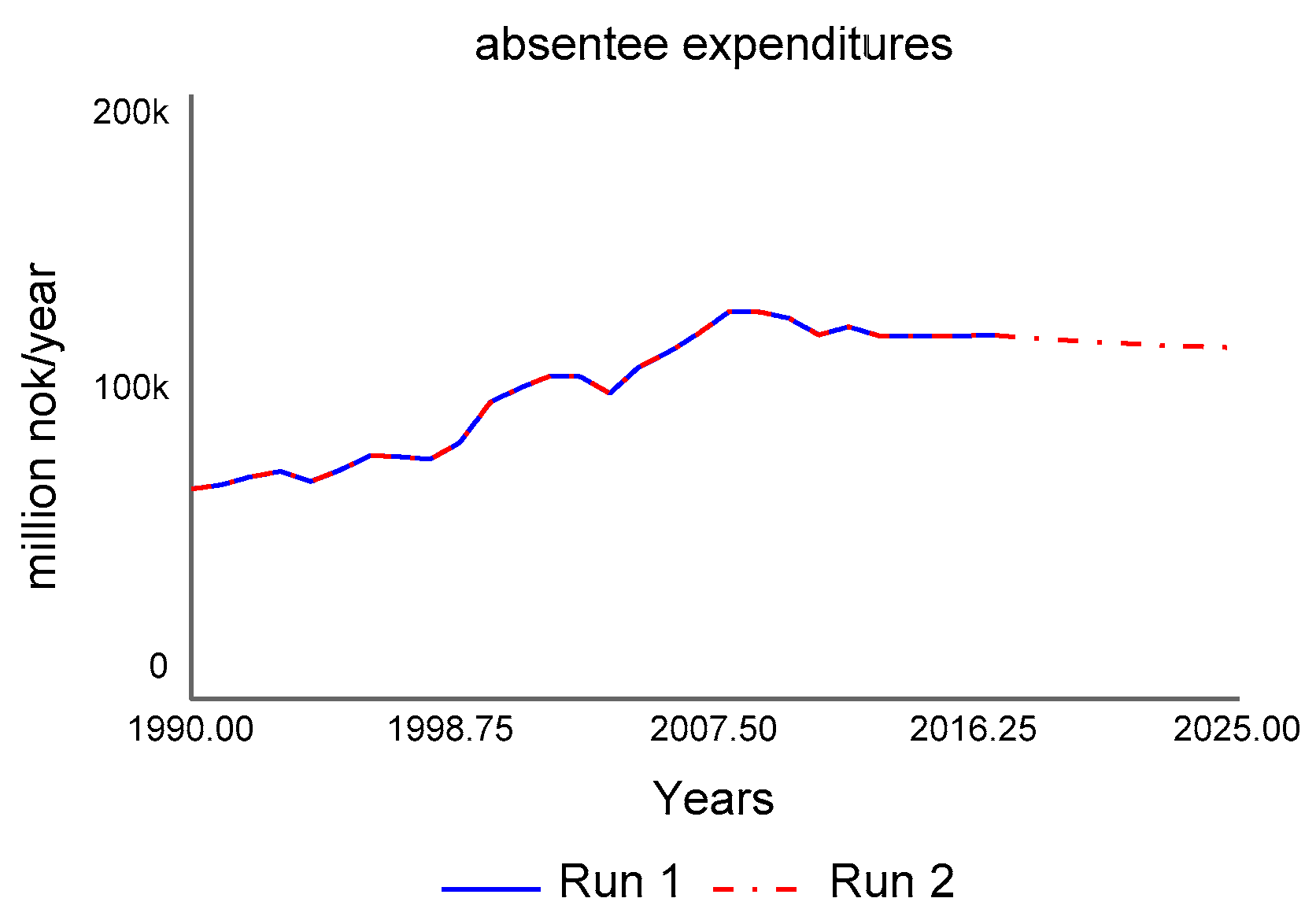
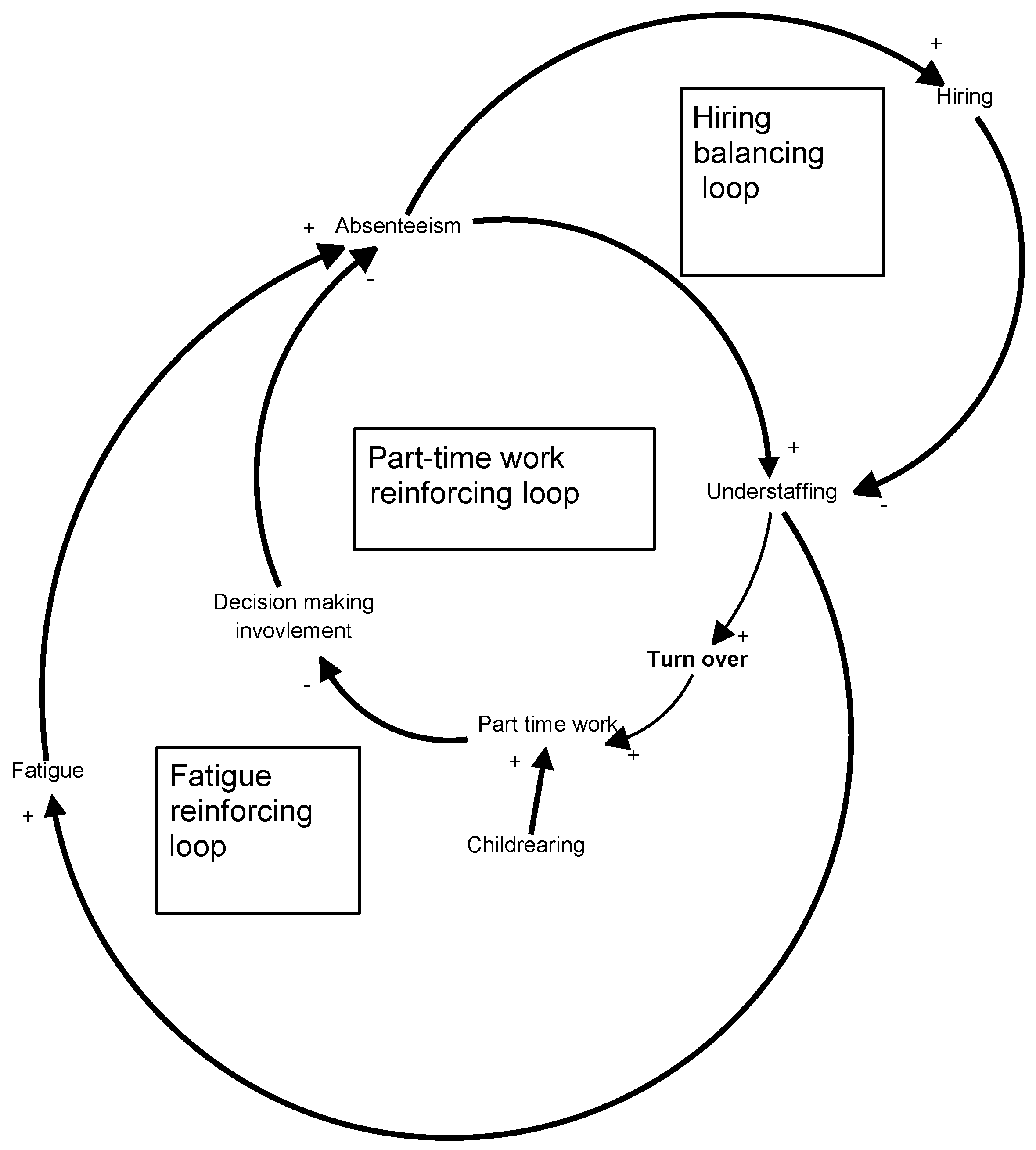
© 2018 by the author. Licensee MDPI, Basel, Switzerland. This article is an open access article distributed under the terms and conditions of the Creative Commons Attribution (CC BY) license (http://creativecommons.org/licenses/by/4.0/).
Share and Cite
Palmer, E. The Heavy Cost of Care: Systemic Challenges in Norwegian Work Absenteeism. Soc. Sci. 2018, 7, 94. https://doi.org/10.3390/socsci7060094
Palmer E. The Heavy Cost of Care: Systemic Challenges in Norwegian Work Absenteeism. Social Sciences. 2018; 7(6):94. https://doi.org/10.3390/socsci7060094
Chicago/Turabian StylePalmer, Erika. 2018. "The Heavy Cost of Care: Systemic Challenges in Norwegian Work Absenteeism" Social Sciences 7, no. 6: 94. https://doi.org/10.3390/socsci7060094
APA StylePalmer, E. (2018). The Heavy Cost of Care: Systemic Challenges in Norwegian Work Absenteeism. Social Sciences, 7(6), 94. https://doi.org/10.3390/socsci7060094




